Avoid getting scammed by fake "Social Security Administrator" emails
Phishing/ScamAlso Known As: "Social Security Administrator" spam email
Get free scan and check if your device is infected.
Remove it nowTo use full-featured product, you have to purchase a license for Combo Cleaner. Seven days free trial available. Combo Cleaner is owned and operated by RCS LT, the parent company of PCRisk.com.
What kind of email is "Social Security Administrator"?
After examining the "Social Security Administrator" email, we determined that it is spam. We found two variants of this mail; the text in the body of the letter was the same, while the attachments differed. This scam uses false claims regarding serious Social Security number issues to trick recipients into calling fake helplines.
Spam mail of this kind is typically used to deceive victims into disclosing private information and/or giving scammers money.
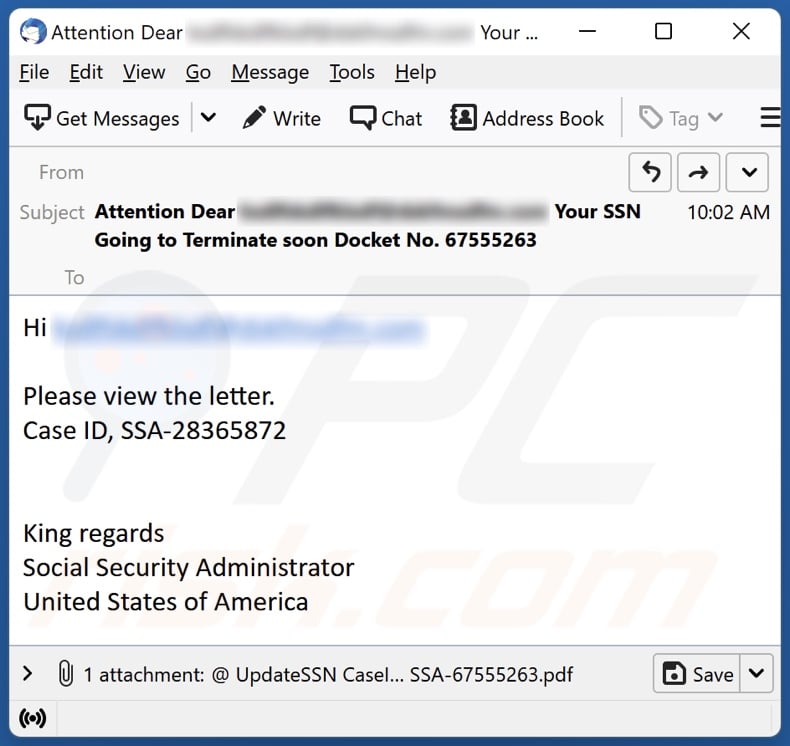
"Social Security Administrator" email scam overview
The email with the subject "Attention Dear [-] Your SSN Going to Terminate soon Docket No. 67555263" (may vary) urges the recipient to review the attached PDF file.
There are at least two attachment variants, both of which make similar false claims. The documents are supposedly issued by the United States Social Security Administration (SSA) and make false claims regarding the recipient's Social Security number (SSN).
One of the documents notifies that the SSN was used for illegal and fraudulent activities, and as such – will be suspended within 24 hours. The other version is lengthier and likewise centers on the suspension of the recipient's SSN. Both encourage the recipient to call the provided support number.
It must be stressed that all these claims are false, and they are in no way associated with any legitimate entities.
How the scam progresses once the victim calls the telephone number can vary drastically. It is highly likely that the scammers will employ various scare tactics to trick victims into compliance (e.g., claims regarding crimes made using their identity, potential fines and sentencing, etc.).
All scams aim to generate revenue – however, how they achieve this goal differs. This scheme could target victims' personal information, such as names, occupations, SSNs, addresses, and other related details, that the cyber criminals could use to steal their identities.
Account log-in credentials (e.g., social media, social networking, emails, online banking, e-commerce, digital wallets, etc.) are also of interest to scammers.
Callback scams can incorporate elements of tech support scams, more information on which can be found in our article on UltraViewer – a remote access program often used in these schemes.
Cyber criminals can request money from victims directly; the bogus pretext could be the payment of fees, bills, or fines, as well as the return of alleged excess funds. Difficult-to-trace methods are preferred by criminals, e.g., cryptocurrencies, gift cards, pre-paid vouchers, or cash hidden in innocent-looking packages and shipped. By using these methods, scammers attempt to evade persecution and prevent victims from retrieving their funds.
In summary, by trusting an email like "Social Security Administrator" – users can experience system infections, serious privacy issues, financial losses, and even identity theft.
If you have allowed cyber criminals to remotely access your device – you must first disconnect it from the Internet. Secondly, remove the remote access software that the scammers used, as they may not need your consent to reconnect. Lastly, run a full system scan with an anti-virus and remove all detected threats.
And if you've provided your log-in credentials – change the passwords of all possibly exposed accounts and inform their official support. If the disclosed information was of a different personal nature (e.g., ID card details, passport scans/photos, credit card numbers, etc.) – immediately contact the appropriate authorities.
| Name | "Social Security Administrator" spam email |
| Threat Type | Phishing, Scam, Social Engineering, Fraud |
| Fake Claim | Recipient's Social Security Number was used for illegal activities. |
| Disguise | United States Social Security Administration |
| Support Scammer Phone Number(s) | +1(866) 222-0153, +1(888) 224-7014, 888-321-9514, (805) 314-1955 |
| Symptoms | Unauthorized online purchases, changed online account passwords, identity theft, illegal access of the computer. |
| Distribution methods | Deceptive emails, rogue online pop-up ads, search engine poisoning techniques, misspelled domains. |
| Damage | Loss of sensitive private information, monetary loss, identity theft. |
| Malware Removal (Windows) |
To eliminate possible malware infections, scan your computer with legitimate antivirus software. Our security researchers recommend using Combo Cleaner. Download Combo CleanerTo use full-featured product, you have to purchase a license for Combo Cleaner. 7 days free trial available. Combo Cleaner is owned and operated by RCS LT, the parent company of PCRisk.com. |
Similar spam campaign examples
"Walmart Order", "Suspicious Login Attempt On Your Windows Computer", "PayPal - Order Has Been Completed", "Norton360 Total Protection Subscription Charge", and "Anti-Fraud International Monitoring Group Compensation" are just a few examples of spam emails that promote callback scams.
Deceptive mail is used to facilitate a wide variety of scams, e.g., phishing, sextortion, technical support, refund, etc. However, it is also employed in malware proliferation (e.g., trojans, ransomware, etc.).
Due to how widespread and potentially well-crafted this mail can be – we strongly recommend exercising caution with incoming emails, DMs/PMs, SMSes, and other messages.
How do spam campaigns infect computers?
Spam emails can contain malicious files as attachments or download links. They come in various formats, e.g., executables (.exe, .run, etc.), archives (RAR, ZIP, etc.), documents (PDF, Microsoft Office, Microsoft OneNote, etc.), JavaScript, and so on.
Once a virulent file is executed, run, or otherwise opened – the infection process (i.e., malware download/installation) is initiated. For example, Microsoft Office files infect systems by executing malicious macro commands, while infectious OneNote documents need users to click on embedded files or links.
How to avoid installation of malware?
It is paramount to treat incoming emails and other messages with caution. We advise against opening attachments or links present in suspicious/irrelevant mail, as they can be virulent. We also recommend using post-2010 Microsoft Office versions since they have the "Protected View" mode that prevents automatic macro command execution.
It must be mentioned that malware is not proliferated only through spam mail. Therefore, we advise vigilance when browsing since fake and malicious online content typically appears legitimate and innocuous.
Additionally, all downloads must be performed from official and trustworthy sources. Another recommendation is to activate and update software by using functions/tools provided by genuine developers, as illegal activation tools ("cracks") and third-party updates may contain malware.
We must emphasize the importance of having a dependable anti-virus installed and kept up-to-date. Security programs must be used to run regular system scans and to remove detected threats/issues. If you've already opened malicious attachments, we recommend running a scan with Combo Cleaner Antivirus for Windows to automatically eliminate infiltrated malware.
Text presented in the "Social Security Administrator" spam email letter:
Subject: Attention Dear ******** Your SSN Going to Terminate soon Docket No. 67555263
Hi ********
Please view the letter.
Case ID, SSA-28365872
King regards
Social Security Administrator
United States of America
Screenshots of the files attached to the "Social Security Administrator" spam emails:
An example of Social Security Administration-themed spam email spreading a malicious ScreenConnect installer:
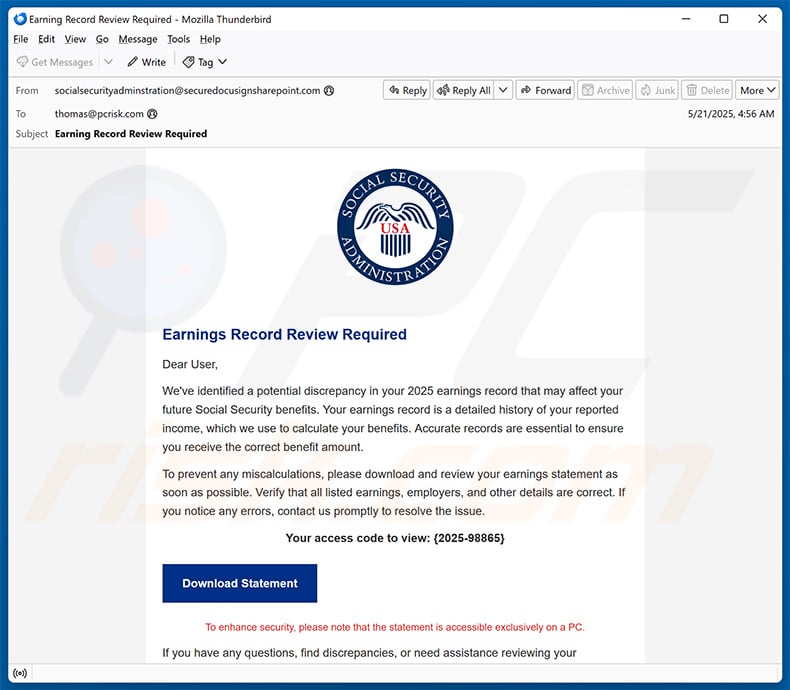
Text presented within:
Subject: Earning Record Review Required
Social Security Administration
Earnings Record Review RequiredDear User,
We've identified a potential discrepancy in your 2025 earnings record that may affect your future Social Security benefits. Your earnings record is a detailed history of your reported income, which we use to calculate your benefits. Accurate records are essential to ensure you receive the correct benefit amount.
To prevent any miscalculations, please download and review your earnings statement as soon as possible. Verify that all listed earnings, employers, and other details are correct. If you notice any errors, contact us promptly to resolve the issue.
Your access code to view: {2025-98865}
Download StatementTo enhance security, please note that the statement is accessible exclusively on a PC.
If you have any questions, find discrepancies, or need assistance reviewing your statement, please contact our office at 1-800-772-1213 or visit www.ssa.gov.
Thank you,
Social Security AdministrationThis email was sent by the Social Security Administration. Please do not reply directly to this email. For support, visit www.ssa.gov.
Instant automatic malware removal:
Manual threat removal might be a lengthy and complicated process that requires advanced IT skills. Combo Cleaner is a professional automatic malware removal tool that is recommended to get rid of malware. Download it by clicking the button below:
DOWNLOAD Combo CleanerBy downloading any software listed on this website you agree to our Privacy Policy and Terms of Use. To use full-featured product, you have to purchase a license for Combo Cleaner. 7 days free trial available. Combo Cleaner is owned and operated by RCS LT, the parent company of PCRisk.com.
Quick menu:
- What is "Social Security Administrator" spam email?
- Types of malicious emails.
- How to spot a malicious email?
- What to do if you fell for an email scam?
Types of malicious emails:
![]() Phishing Emails
Phishing Emails
Most commonly, cybercriminals use deceptive emails to trick Internet users into giving away their sensitive private information, for example, login information for various online services, email accounts, or online banking information.
Such attacks are called phishing. In a phishing attack, cybercriminals usually send an email message with some popular service logo (for example, Microsoft, DHL, Amazon, Netflix), create urgency (wrong shipping address, expired password, etc.), and place a link which they hope their potential victims will click on.
After clicking the link presented in such email message, victims are redirected to a fake website that looks identical or extremely similar to the original one. Victims are then asked to enter their password, credit card details, or some other information that gets stolen by cybercriminals.
![]() Emails with Malicious Attachments
Emails with Malicious Attachments
Another popular attack vector is email spam with malicious attachments that infect users' computers with malware. Malicious attachments usually carry trojans that are capable of stealing passwords, banking information, and other sensitive information.
In such attacks, cybercriminals' main goal is to trick their potential victims into opening an infected email attachment. To achieve this goal, email messages usually talk about recently received invoices, faxes, or voice messages.
If a potential victim falls for the lure and opens the attachment, their computers get infected, and cybercriminals can collect a lot of sensitive information.
While it's a more complicated method to steal personal information (spam filters and antivirus programs usually detect such attempts), if successful, cybercriminals can get a much wider array of data and can collect information for a long period of time.
![]() Sextortion Emails
Sextortion Emails
This is a type of phishing. In this case, users receive an email claiming that a cybercriminal could access the webcam of the potential victim and has a video recording of one's masturbation.
To get rid of the video, victims are asked to pay a ransom (usually using Bitcoin or another cryptocurrency). Nevertheless, all of these claims are false - users who receive such emails should ignore and delete them.
How to spot a malicious email?
While cyber criminals try to make their lure emails look trustworthy, here are some things that you should look for when trying to spot a phishing email:
- Check the sender's ("from") email address: Hover your mouse over the "from" address and check if it's legitimate. For example, if you received an email from Microsoft, be sure to check if the email address is @microsoft.com and not something suspicious like @m1crosoft.com, @microsfot.com, @account-security-noreply.com, etc.
- Check for generic greetings: If the greeting in the email is "Dear user", "Dear @youremail.com", "Dear valued customer", this should raise suspiciousness. Most commonly, companies call you by your name. Lack of this information could signal a phishing attempt.
- Check the links in the email: Hover your mouse over the link presented in the email, if the link that appears seems suspicious, don't click it. For example, if you received an email from Microsoft and the link in the email shows that it will go to firebasestorage.googleapis.com/v0... you shouldn't trust it. It's best not to click any links in the emails but to visit the company website that sent you the email in the first place.
- Don't blindly trust email attachments: Most commonly, legitimate companies will ask you to log in to their website and to view any documents there; if you received an email with an attachment, it's a good idea to scan it with an antivirus application. Infected email attachments are a common attack vector used by cybercriminals.
To minimise the risk of opening phishing and malicious emails we recommend using Combo Cleaner Antivirus for Windows.
Example of a spam email:

What to do if you fell for an email scam?
- If you clicked on a link in a phishing email and entered your password - be sure to change your password as soon as possible. Usually, cybercriminals collect stolen credentials and then sell them to other groups that use them for malicious purposes. If you change your password in a timely manner, there's a chance that criminals won't have enough time to do any damage.
- If you entered your credit card information - contact your bank as soon as possible and explain the situation. There's a good chance that you will need to cancel your compromised credit card and get a new one.
- If you see any signs of identity theft - you should immediately contact the Federal Trade Commission. This institution will collect information about your situation and create a personal recovery plan.
- If you opened a malicious attachment - your computer is probably infected, you should scan it with a reputable antivirus application. For this purpose, we recommend using Combo Cleaner Antivirus for Windows.
- Help other Internet users - report phishing emails to Anti-Phishing Working Group, FBI’s Internet Crime Complaint Center, National Fraud Information Center and U.S. Department of Justice.
Frequently Asked Questions (FAQ)
Why did I receive this email?
Cyber criminals send out spam emails in mass-scale campaigns. Therefore, this mail is not personal, and thousands of users receive identical messages.
I have provided my personal information when tricked by this spam email, what should I do?
If you have disclosed your account credentials – change the passwords of all possibly exposed accounts and inform their official support without delay. And if you've provided other private data (e.g., ID card details, passport scans/photos, credit card numbers, etc.) – immediately contact relevant authorities.
I have allowed cyber criminals to remotely access my computer, what should I do?
If you have allowed scammers to access your device remotely, you must first disconnect it from the Internet. Afterward, uninstall the remote access software that the cyber criminals used. Once the program has been removed, run a complete system scan using an anti-virus and eliminate all detected threats.
I have read a spam email but didn't open the attachment, is my computer infected?
No, merely opening/reading an email will not trigger any malware download/installation processes. Devices are infected when malicious attachments or links are opened/clicked.
I have downloaded and opened a file attached to a spam email, is my computer infected?
Whether your device was infected depends on the file's purpose and format. Executables (.exe, .run, etc.) cause infections almost without fail upon opening. While malicious documents (.doc, .xls, .one, .pdf, etc.) may require additional user interaction (e.g., enabling macro commands, clicking embedded content, etc.) to begin malware download/installation processes.
Will Combo Cleaner remove malware infections present in email attachments?
Yes, Combo Cleaner is designed to scan devices and eliminate detected threats. It is capable of removing practically all known malware infections. Keep in mind that since high-end malicious software usually hides deep within systems – running a full system scan is paramount.
Share:

Tomas Meskauskas
Expert security researcher, professional malware analyst
I am passionate about computer security and technology. I have an experience of over 10 years working in various companies related to computer technical issue solving and Internet security. I have been working as an author and editor for pcrisk.com since 2010. Follow me on Twitter and LinkedIn to stay informed about the latest online security threats.
PCrisk security portal is brought by a company RCS LT.
Joined forces of security researchers help educate computer users about the latest online security threats. More information about the company RCS LT.
Our malware removal guides are free. However, if you want to support us you can send us a donation.
DonatePCrisk security portal is brought by a company RCS LT.
Joined forces of security researchers help educate computer users about the latest online security threats. More information about the company RCS LT.
Our malware removal guides are free. However, if you want to support us you can send us a donation.
Donate
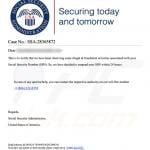
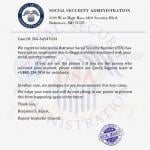
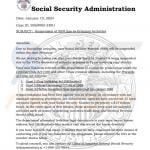
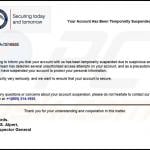
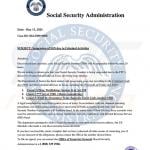
▼ Show Discussion